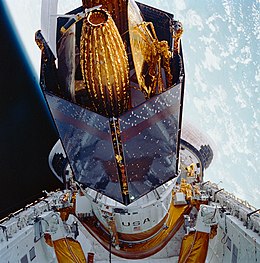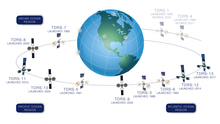TDRS-3
 TDRS-C aboard Discovery | |
| Mission type | Communication |
|---|---|
| Operator | NASA |
| COSPAR ID | 1988-091B |
| SATCAT no. | 19548 [1] |
| Mission duration | Planned: 10 years Elapsed: 33 years, 3 months, 20 days |
| Spacecraft properties | |
| Bus | TDRS |
| Manufacturer | TRW |
| Launch mass | 2,224.9 kg (4,905 lb)[2] |
| Dimensions | 17.3 × 14.2 m (57 × 47 ft)[2] |
| Power | 1700 watts[2] |
| Start of mission | |
| Launch date | 29 September 1988, 15:37:00 UTC |
| Rocket | Space Shuttle Discovery STS-26 / IUS |
| Launch site | Kennedy Space Center LC-39B |
| Contractor | Rockwell International |
| Orbital parameters | |
| Reference system | Geocentric orbit |
| Regime | Geostationary orbit |
| Longitude | 151° West (1988) 171° West (1988–1990) 174° West (1990–1991) 62° West (1991–1994) 171° West (1994–1995) 85° East (1995–2009) 49° West (2009–) |
| Epoch | 29 September 1988 [3] |
TDRS-3, known before launch as TDRS-C, is an American communications satellite, of first generation, which is operated by NASA as part of the Tracking and Data Relay Satellite System. It was constructed by TRW, and is based on a custom satellite bus which was used for all seven first generation TDRS satellites.[4]
Launch[]

The TDRS-C satellite was launched aboard Space Shuttle Discovery during the STS-26 mission in 1988; the first Shuttle flight since the Challenger disaster which had resulted in the loss of the previous TDRS satellite, TDRS-B. Discovery launched from Launch Complex 39B at the Kennedy Space Center at 15:37:00 UTC on 29 September 1988.[5] TDRS-C was deployed from Discovery around six hours after launch, and was raised to geostationary orbit by means of an Inertial Upper Stage.[5]
Deployment[]
The two-stage solid-propellent Inertial Upper Stage made two burns. The first stage burn occurred shortly after deployment from Discovery, and placed the satellite into a geosynchronous transfer orbit. At 04:30 UTC on 30 September 1988, it reached apogee, and the second stage fired, placing TDRS-C into geosynchronous orbit. At this point it received its operational designation. Although the TDRS-2 designation had not been assigned, TDRS-C was given the designation TDRS-3 as NASA did not want to reuse the designation which had been intended for the STS-51-L payload.[6] It was briefly placed at a longitude 151° West of the Greenwich Meridian, before being moved to 171.0° West before the end of 1988, from where it provided communications services to spacecraft in Earth orbit, including Space Shuttles. In 1990, it was relocated to 174.0° West, and again in 1991 to 62.0° West. In 1994, it returned to 171.0° West.[7][8] In June 1995, it was moved to 85.0° East, from where it was used primarily for communications with spacecraft such as the Compton Gamma Ray Observatory and the Hubble Space Telescope.[7][9] In October 2009, as NASA began decommissioning TDRS-1, TDRS-3 was moved to 49.0° West,[10] where it remains in storage as of 2020.[11]


See also[]
References[]
- ^ McDowell, Jonathan. "SATCAT". Jonathan's Space Pages. Retrieved 18 March 2014.
- ^ a b c "Tracking and Data Relay Satellite (TDRS) Characteristics". NASA. 10 September 2014. Retrieved 28 July 2020.
- ^ "NASA – NSSDCA – Spacecraft – Trajectory Details". nssdc.gsfc.nasa.gov. Retrieved 2 May 2018.
 This article incorporates text from this source, which is in the public domain.
This article incorporates text from this source, which is in the public domain.
- ^ Krebs, Gunter. "TDRS 1, 2, 3, 4, 5, 6". Gunter's Space Page. Retrieved 8 August 2009.
- ^ a b McDowell, Jonathan. "Launch Log". Jonathan's Space Page. Retrieved 8 August 2009.
- ^ "Designation". NASA'S Tracking and Data Relay Satellite. NASA. December 1992. Archived from the original on 3 August 2009.
 This article incorporates text from this source, which is in the public domain.
This article incorporates text from this source, which is in the public domain.
- ^ a b "TDRS 3". TSE. Retrieved 8 August 2009.
- ^ McDowell, Jonathan. "Index". Geostationary Orbit Catalog. Jonathan's Space Page. Retrieved 8 August 2009.
- ^ "The TDRS-J satellite". Spaceflight Now. 1 December 2002. Retrieved 8 August 2009.
- ^ Clark, Stephen (13 October 2009). "NASA retires 'queen' of tracking satellite fleet". Spaceflight Now. Retrieved 18 March 2014.
- ^ "Tracking and Data Relay Satellite (TDRS) Fleet". NASA. 11 February 2014. Retrieved 18 March 2014.
 This article incorporates text from this source, which is in the public domain.
This article incorporates text from this source, which is in the public domain.
- Communications satellites in geostationary orbit
- Spacecraft launched in 1988
- TDRS satellites
- Spacecraft launched by the Space Shuttle
